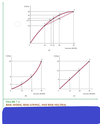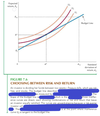Chapter 7 Flashcards
(11 cards)
1
Q
Describing Risk
To measure risk we must know:
Interpreting Probability
- –*
- –*
- *
A
Describing Risk
To measure risk we must know:
- All of the possible outcomes
- The probability or likelihood that a given outcome will occur
Interpreting Probability
- – Objective probability*
- Observed frequency of past events
- – Subjective probability*
- Perception that an outcome will occur
- Influenced by different information or different abilities to process the
same information – based on judgment or experience
2
Q
2 measures to help describe and compare risky choices
- measures the
- Example: Investment in offshore drilling exploration: 2 possible outcomes
- Success – the stock price increases from $30 to $40/share
- Failure – the stock price falls from $30 to $20/share
- Objective Probability
- 100 explorations: 25 successes and 75 failures
- Probability of success = and probability of failure =
- EV = formula = + =
Variability
- Extent to which
- How much
- Example: Suppose you are choosing between two part-time sales jobs that have the same expected income ($1,500) (table image)
- Greater variability from expected values signals
- Variability comes from
- Difference between
- Calculating Deviation in example
- take
- and then to calculate
- σ =
- σ1= =

A
2 measures to help describe and compare risky choices
-
Expected value
-
Probability-weighted average of the payoffs or values associated with all
possible outcomes- measures the central tendency; the payoff or value expected on average
- Example: Investment in offshore drilling exploration: 2 possible outcomes
- Success – the stock price increases from $30 to $40/share
- Failure – the stock price falls from $30 to $20/share
- Objective Probability
- 100 explorations: 25 successes and 75 failures
- Probability of success = 0.25 and probability of failure = 0.75
- EV = Pr(success)(value of success) + Pr(failure)(value of failure)= 0.25($40/share) + 0.75($20/share) = $25/share
-
Probability-weighted average of the payoffs or values associated with all
Variability
- Extent to which possible outcomes of an uncertain event differ
- How much variation exists in the possible choices
- Example: Suppose you are choosing between two part-time sales jobs that have the same expected income ($1,500) (table image)
- Greater variability from expected values signals greater risk
- Variability comes from deviations in payoffs
- Difference between expected payoff and actual payoff
- Calculating Deviation in example
- take expected payoff: 2000 for job 1outcome 1 and substract actual payoff E(x1) 1500 so deviation = 1500
- and then to calculate σ(standard deviation) you take those deviations for each job , square them and multiply by theres probabilities
- σ = racine(Pr (X − E(X ))^2 + Pr (X − E(X ))^2)
- σ1= racine((5. 250,000) +(5. 250,000) =500

3
Q
Preferences toward risk
- Utility function:
- Marginal utility:
- Expected utility:
- Expected utility(Image):where, i

A
Preferences toward risk
- Utility function: Assigns a level of utility to each possible market basket.
- Marginal utility: the additional satisfaction obtained by consuming an additional amount of a good.
- Expected utility: Sum of the utilities associated with all possible outcomes, weighted by the probability that each outcome will occur.
- Expected utility(Image):where, u(Xi) is the utility one obtains with outcome Xi

4
Q
Different preferences towards risk:
- Risk-averse:
- Risk neutral:
- Risk loving:

A
Different preferences towards risk:
- Risk-averse:Condition of preferring a certain income to a risky income with the same expected value.
- Risk neutral: Condition of being indifferent between a certain income and an uncertain income with the same expected value.
- Risk loving: Condition of preferring a risky income to a certain income with the same expected value.

5
Q
Risk Premium

Risk Premium:
A
Risk Premium

Risk Premium: The risk premium is the maximum amount of money that a risk-averse person will pay to avoid taking a risk.
6
Q
For a risk-averse person:
- The steeper the indifference curve,
- Each individual has

A
For a risk-averse person:
- The steeper the indifference curve, the more risk-averse this person is, vice versa.
- Each individual have infinite number of indifference curves, and each indifference curve represents at a given utility U, the combination between risk of the income and expected income.

7
Q
Reducing risk
-
: practice of
- Negatively correlated variables:
- Positively correlated variables:
-
…:…
- The law of large number:
- Actuarial fairness:
- The value of information:
A
Reducing risk
-
Diversification: practice of reducing risk by allocating resources to a variety of activities whose outcomes are not closely related. One can reduce risk through diversification. (e.g. mutual fund: an organization that pools funds of individual investors to buy a large number of different stocks or other financial assets.)
- Negatively correlated variables: Variables having a tendency to move in opposite directions.
- Positively correlated variables: variables having a tendency to move in the same direction.
-
Insurance: Buying insurance assures a person of having the same income whether or not there is a loss. For a risk-averse consumer, the guarantee of the same income regardless of the outcome generates more utility than would be the case if that person had a high income when there was no loss and a low income when a loss occurred.
- The law of large number: Although single events may be random and largely unpredictable, the average outcome of many similar events can be predicted. (e.g. tossing a coin 100 times)
- Actuarial fairness: A situation in which an insurance premium is equal to the expected payout
- The value of information: Difference between the expected value of a choice when there is complete information and the expected value when information is incomplete.
8
Q
The Demand for risky Assets
-
Asset: something that
- Risky asset:
- Riskless (risk-free) asset:
- Asset Returns:
- Real return:
- Expected return:
- Actual return:

A
The Demand for risky Assets
-
Asset: something that provides a flow of money or services to its owner.
- Risky asset: Asset that provides an uncertain flow of money or services to its owner
- Riskless (risk-free) asset: Asset that provides a flow of money or services that is known with certainty
- Asset Returns: total monetary flow of an asset as a fraction of its price; asset return can be positive or negative
- Real return: nominal return less the rate of inflation.
- Expected return: return that an asset should earn on average;
- Actual return: return that an asset actually earns.

9
Q

A

10
Q

A

11
Q

A



